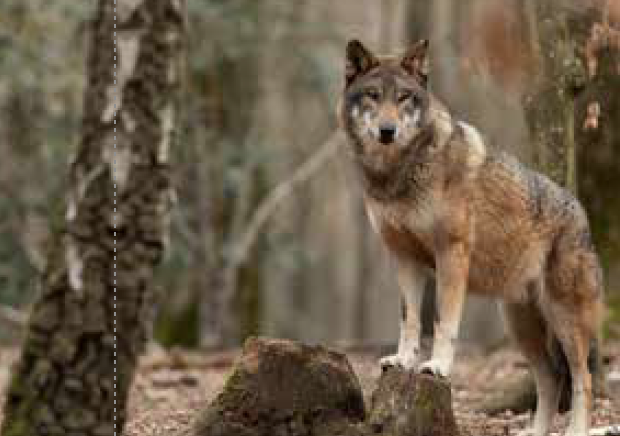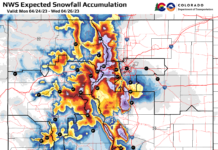by Marissa Lorenz
Just over a year ago Coloradans voted to support a ballot measure to reintroduce gray wolves to the Colorado landscape. The initiative was a controversial one, seeming to pit rural agricultural communities and wildlife managers against the much larger urban populations in a decision whose direct impacts would primarily affect those rural residents and their economies.
In the end, Proposition 114 passed by a narrow margin (50.82%). It only passed in one-fifth of Colorado counties-Grand County voted 64.26% against the measure-and did not pass in the bulk of the other Western Slope communities where reintroduction was proposed.
It tasked the Colorado Parks and Wildlife (CPW) Commission with the planning, restoration, and management of the once endemic species on public lands west of the Continental Divide by the end of 2023. It further mandated that scientific, economic, and social concerns be incorporated into the plan, inviting public input along the way.
In response to the voter directive, CPW formed a Technical Working Group (TWG) and Stakeholder Advisory Group (SAG) earlier this year to help guide the planning and implementation of the program. And in recent weeks, each of those groups has released an important first report.
Technical Recommendations
The TWG, whose responsibility it is to “contribute expertise towards the development of conservation objectives, management strategies, damage prevention, and compensation planning,” released its Final Report on Wolf Restoration Logistics Recommendations.
The report offers best practice and science-based ideas on capture, animal handling, and reintroduction considerations.
Highlights from the report indicate that: Gray wolves from Idaho, Montana, Wyoming, and a mix from those states are recommended as the preferred donor populations present in Colorado and listed as endangered, are of the least preference.
Net gun, helicopter darting, and discretion of source population managers are the preferred capture methods with snares and traps presenting various concerns for injury and success rate.
A mix of color, a 50-50 sex ratio, and any aged animal except young of that year are considered slightly preferred.
Wolves not known to be a depredator (causing mass predation), whether having been exposed to livestock or not, are preferred.
Animals should be held in captivity for the shortest time possible. GPS collars are the preferred method for tracking relocated wolves.
Standard protocols and expert care is necessary to ensure animal health when in captivity and during transport.
A hard release in winter or fall is the preferred method of release.
No specific number of animals for relocation has been identified, nor a given number or named location of release areas was recommended, with alternative options for all being considered as “having technical merit.”
Grand County Commissioner and fourth-generation rancher Merrit Linke serves on the 17-person working group, oneof two persons without career expertise and experience around wolf reintroduction.
Linke acknowledges having been strongly opposed to Prop 114. He explains that he thinks most voters didn’t understand the geographic area included in the measure, which does not include many high mountain communities of potential habitat, such as Summit County, Gilpin County, and even Jackson County, where Colorado’s first documented wolf litter in over 80 years was born this past summer.
And he indicates that many don’t take into account the role that ag land, preserving open spaces and wildlife habitat, plays in the tourist economy and how that tourist presence means a much greater population density in Colorado’s reintroduction areas than in other states that have already undergone wolf reinstitution, such as Montana and Idaho.
Linke admits to having had an “inner struggle” about whether or not to participate in the working group. But he decided that it was better to be a part of the process and now sees his role as being a voice for rural citizens, especially ag producers.
The Grand County native says that he feels listened to within the group as he continues to emphasize how important it is “to get the process right to start with, because it would be very hard to undo mistakes that grow beyond a way to effectively manage logistically and societally,” like the loss of other significant animals such as elk, moose, and livestock.
He points out that in Montana and Idaho wolf populations have grown to such an extent that they have implemented hunting seasons, a potential decision that he doesn’t see as having political support in Colorado, leaving no foreseen means for controlling potential overpopulation of the natural predators.
Linke concludes that he is now “cautiously optimistic” about the outcome of the reintroduction as one with “hopefully little impact to ag.” He describes next discussions as addressing harm prevention and livestock compensation, which will result in another set of recommendations to the CPW Commission, the final policy deciders.
Public Input Results
The Stakeholders Advisory Group summarizes the input provided by Coloradans on the development of the Colorado Wolf Restoration and Management Plan in their recently-released Summer 2021 Public Engagement Report.
Julie Shapiro, Senior Policy Director at the Keystone Policy Center, reports that, in partnership with CPW and the SAG, Keystone surveyed more than 3,400 respondents over the past summer, hosting 47 meetings-including in-person open houses, in-person geographic and virtual interest-based focus groups, in-person Tribal consultations, virtual town halls-and an online comment form in the summer of 2021.
“The Public Engagement Report qualitatively details the various perspectives gathered during our summer public engagement effort,” explains Shapiro. “The report does not attempt to draw conclusions regarding which specific restoration and management strategies were favored by participants in the process, but instead details the underlying rationales, interests and values expressed by those who participated.”
Shapiro notes that public feedback was provided on such diverse topics as wolf-livestock interaction, conflict minimization practices, compensation programs, lethal/non-lethal management of conflict wolves, partnership and funding, and outreach and education for various audiences, including ag producers, recreators, and tourists.
Shapiro indicates that the report offers “potential principles of common ground,” such as:
• Reflecting diverse interests and values of Coloradans
• Including scientific, social, and economic considerations for an adaptive and flexible model for wolf management
• Proactively minimizing livestock conflict where possible and fairly compensating when loss occurs
• Offering factual and tailored educational resources
• Prioritizing meaningful, ongoing, and trust-based partnerships with various stakeholders and communities, including funding and sustainability partners
Next Collective Steps
The SAG and TWG will meet jointly in December, entering into a second phase of planning. They will bring together their separate areas of research and develop a working plan that “will be presented to the Commission and opened for public comment and input before a final Gray Wolf Management and Restoration plan is approved by the Commission,” according to Rebecca Ferrell, legislative procedures spokesperson fo the Parks and Wildlife Commission.
Ferrell assures citizens that “Publi comment opportunities will continue beyond the period of engagement synthesized in the report, including public comment at Stakeholder Advisory Group meetings, Parks and Wildlife Commission meetings, and via an online comment form.”
To learn more about and/or participate in Colorado’s Wolf Reintroduction and Management process, find all reports, current recommendations, meeting information, and comment links at www.wolfengagementco.org.
For more about Colorado Parks and Wildlife, the CPW Commission, and wildlife-related management and recreation, go to cpw.state.co.us.








